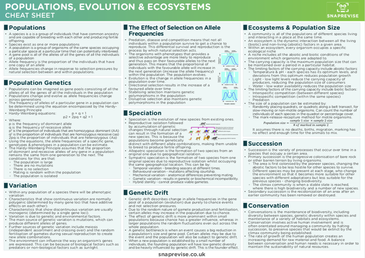A-LEVEL BIOLOGY AQA NOTES
populations
Populations
- A species is a is a group of individuals that have common ancestry and are capable of breeding with each other and producing fertile offspring.
- Species exist as one or more populations
- A population is a group of organisms of the same species occupying a particular space at a particular time that can potentially interbreed.
- A gene pool is all of the alleles of all the genes of all the individuals of a population
- Allele frequency is the proportion of the individuals that have one copy of an allele
- Allele frequencies change in response to selection pressures by natural selection between and within populations.
Population Genetics
- Populations can be imagined as gene pools consisting of all the alleles of all the genes of all the individuals in the population
- Populations change and evolve as allele frequencies change across generations
- The frequency of alleles of a particular gene in a population can be determined using the equation encompassed by the Hardy-Weinberg Principle
- Hardy-Weinberg equations:
p + 1 = 1
p^2 + 2 pq + q^2 = 1
p^2 + 2 pq + q^2 = 1
Where:
p is the frequency of dominant allele
q is the frequency of recessive allele
p^2 is the proportion of individuals that are homozygous dominant (AA)
q^2 is the proportion of individuals that are homozygous recessive (aa)
2pq is the proportion of individuals that are heterozygous (Aa)
p is the frequency of dominant allele
q is the frequency of recessive allele
p^2 is the proportion of individuals that are homozygous dominant (AA)
q^2 is the proportion of individuals that are homozygous recessive (aa)
2pq is the proportion of individuals that are heterozygous (Aa)
- Using the equations, the allele frequencies of a specific gene, genotypes & phenotypes in a population can be estimate.
- The Hardy-Weinberg Principle assumes that the proportion of dominant and recessive alleles of any gene in a population remains the same from one generation to the next. The conditions for this are that:
- The population is large
- There are no mutations
- There is no selection
- Mating is random within the population
- The population is isolated

